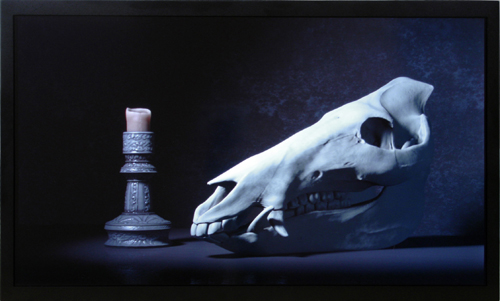What if you wanted to create an image that could stand as the epitome of an artistic movement such as Impressionism or a painting style such as Baroque? Where would you begin? By examining the colors used by the artists associated with them? Or by looking at their subject matter? Jason Salavon, whose show Arrows and Dice can be seen at Eight Modern, has one solution that, on casual inspection, looks like a reduction of these painting styles into simple color components presented as a series of geometric, mandala-like forms. On the surface, that is exactly what they are, but it gets a little more complicated. The artist uses an algorithmic process that takes computer data from a series of uploaded images and interprets the data as a successive, rectangular bands of color arranged in gradations from least saturated at the center to most saturated at the extremities. Take Salavon’s digital C-print called Impressionist Painting; the image was created by digitally amalgamating 100 paintings by Claude Monet and then reinterpreting the data. Salavon used the same process to make another image, based on the 100 works by Peter Paul Rubens, called Baroque Painting. You can see how reliance on certain colors changed over the centuries by comparing the two images; the colors in the Baroque painting are darker shades of brown and reddish-orange, and the effect is more stately than the lighter feeling of the pastel hues in Impressionist Painting.
Portrait (van Dyck) and Portrait (Velazquez), amalgamations based on portraits done by 17th-century painters Anthony vn Dyck and Diego Velazquez, are ghostly images that, rather than appearing as a phantasmagorical fusion of a multitude of faces—as one might expect—look instead like faint impressions rendered so lightly that facial features are barely visible. But the portrait images still maintain a certain consistency in terms of the suggested presence of human form, even if the features cannot be discerned.
A twist on the theme of amalgamation comes in the form of a digital animation on an LCD screen that cycles through a series of change over the course of four hours. The work is called Still Life (Vanitas)because it mimics the vanitas tradition, in which objects that referenced the transient nature of life are chosen as subject matter. Still Life (Vanitas)shows a melting candle beside a skull that slowly morphs from human to baboon and other mammals. The title of the show, Arrows and Dice, is most relevant here; evolution as much a game of chance as a toss of the dice, is suggested by the digital animation and vanitas painting.
Another video work, titled Spigot (Babbling Self-Portrait), is presented as two projections on adjoining walls. One projection shows a live feed of a succession of Google search terms on a grid of colored rectangles. Inside each rectangle, you can see the search terms, which are words such as “Salavon” and “archetypal” and phrases like “Chicago zip codes.” The second projection shows the same data reinterpreted in much the same manner as Impressionist Painting and Baroque Painting, as a successive series of colored squares. In Spigot, the colored squares undulate with a hypnotic movement, growing larger and smaller. The two projections are mirror images of one another. They both contain the same data but present it in different forms. An audio component to the piece is a babbling cacophony of computer-generated voices reading the search terms.
One potential problem with a show like this is that background knowledge of the artist’s creative process is almost essential to fully appreciate the work. In the videos, the process can be inferred with a little patience—you don’t need to watch Still Life (Vanitas)for the entire four hours to get a sense of it—but not so much with Baroque Painting, Impressionist Painting, or the portrait series. These digital C-prints evince a sense of their subject matter but not necessarily of the actual complexity of their design. The notion of amalgamations of pre-existing works by old masters seem so crucial to what these works are about.
Overall, the references to older art traditions using up-to-date technology make for a compelling show that suggest that, even in the digital age, the art of the past is still relevant and still speaks to us as though through an evolutionary chain, now become a sound “byte.”

